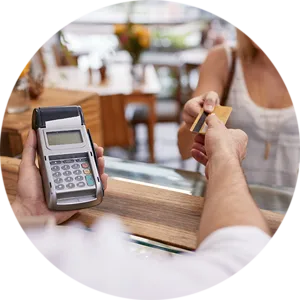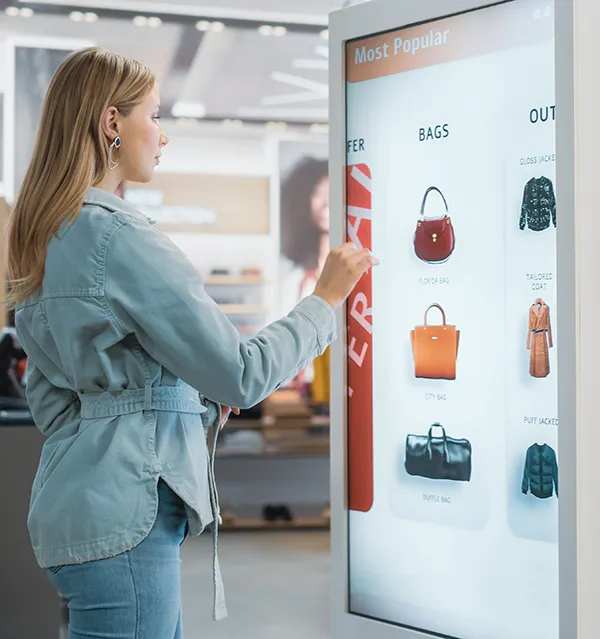THE EVOLUTION OF THE STORE – 1940-1999
1940 – 1999
The Dawn of the Consumer Society
The end of the Second World War and the return of “freedom of movement” saw the beginning of the modern consumer society we know today. Combine that with employment on the rise and a general sense of joy, the format of the store began to expand and diversify rapidly. Over the next fifty years, the consumer would now find themselves faced with an abundance of choice and heading headfirst into an era of excess!
Immerse yourself in the stores of the time with our Late 20th Century Playlist!
Markets, supermarkets, hypermarkets!
Was it the lack of food throughout Europe during the war that created the basis for discounting? Quite possibly! Or was it the low purchasing power of a defeated population that generated this idea in the minds of the Albrecht brothers? Almost certainly! When Théo and Karl Albrecht took over their mother’s small 100sqm shop in 1946, no one expected them to radically transform the world of retail; but that’s exactly what they did…
With their hands initially forced due to limited product quantities, the brothers were inspired by the post-war frugality in Germany and settled for minimalism rather than the modern, innovative outlet they had hoped for when they first took over the business. Life in post-war Germany was difficult and shaped the way the brothers did business. They had little money themselves and could only afford to offer basic, staple items. However, things changed for the brothers rather accidentally when they stumbled upon a brilliant business model: offer the basics at a cheap price point, and people will come. They started cutting costs and waste right from the beginning, and that included cutting out what had been a common sight in grocery stores until then: the counter clerk. The Albrecht brothers picked up on the American tradition of self-service, allowing them to cut costs further. This is a practice that Aldi still uses today by having customers bag their own groceries!
Across Canada and the United States supermarkets rapidly propagated with the growth of automobile ownership and suburban development after World War II. A few years later, they began to grow into hypermarkets across the globe, pushing the earlier models to the extreme. In France, supermarket chain Carrefour set up the first of these new giants in Sainte-Geneviève-des-Bois. This new format consisted of 18 automatic checkouts with conveyor belts, 400 parking spaces, a petrol pump, lines and lines of shopping carts, lots of special offers, and low prices. But above all, fresh produce, groceries, textiles, and household appliances all under the same roof created the perfect combination of choice and convenience. The supermarket customer experience was becoming enhanced for a working population that had no time to waste and desired everything under one roof. With working days getting longer, it was also time to take action on shop opening hours. In 1946, the convenience store chain “7 Eleven” introduced the first extended opening hours of 7am to 11pm and the famous “seven days a week”, revolutionising the customer experience.
The Payment Revolution
During this period, another major revolution was brewing. In 1949, Frank McNamara and his business partner Ralph Schneider created the first example of the credit card – the “Diner’s Club”, which allowed 200 members to dine on credit in 27 New York restaurants. Shortly after the Diner’s Club card came on the scene, the Bank of America launched the first version of the credit card, to allow users to carry a credit card balance from month to month. In 1966, they released the famous BankAmericard.
This exciting new way to pay takes us to 1969 when the modern magnetic strip was invented by an IBM engineer named Forrest Parry. He created a way to adhere a magnetic strip to a plastic card and the invention was soon adopted by credit card companies as a tool for both convenience and security.
This payment revolution saw an even bigger transformation when the first ATM cash machine was installed; said to have been in 1967 by Barclays Bank in North London by John Shepherd-Barron and his team. Barron had been frustrated that he couldn’t cash his cheques after the banks closed (which was often the only time he was free to do so). Inspired by the idea of chocolate vending machines, he came up with a plan to create a machine that dispensed cash instead of chocolate!
By 1973, it was possible to pay for purchases without the usual cash, and a year later, just as the Internet was coming into being, Roland Moreno invented the smart card, the forerunner of the card we still use today. From here, a number of stages followed: in 1980, the first electronic payment terminals appeared; in 1986, the first CB smart card was marketed and, the following year, it incorporated a hologram to enhance security and protect the holder.

In 1990, consumers had to enter a 4-digit code to pay for their purchases, and, six years later, a CB hotline enabled them to stop payment in the event of loss or theft. In 1997, the smart card, a French invention, was exported all over the world and the first international cash withdrawal card was launched.
It was a long journey for a tool that revolutionised the in-store purchasing process. It drastically changed the “check-out” section of retail outlets, with checkouts moving over the next 30 years from payment by “cash” to the modern payment system we still know today. In 1973, we saw the introduction of the barcode, (patented by two American students in 1952) and the invention of the UPC code (the small digits below the vertical lines). This coding became commonplace and product identification sped up point-of-sale processes. Initially reserved for labelling train carriages, they were finally used by the Commander Systems supermarket in 1974 on packets of chewing gum!
Still less expensive than RFID chips – but for how long? It remains the universal product labelling tool, as easy to use for professionals as it is for customers to save time at the checkout. The barcode is a real revolution in the customer experience, but one we rarely talk about!
Feel It and Return!
In addition to these payment changes, this period has also seen a profound change in marketing approaches, which have become increasingly targeted. In particular, incorporating the senses and methods for activating them, sensorial marketing began its development of innovative ‘personalisation’.

In terms of atmosphere, some shops got into the habit of playing music while their customers shopped, in order to entertain them and, of course, encourage them to stay as long as possible in these new living spaces. However, the technological resources of the time meant that retail outlets had to employ someone to take care of the continuous broadcasting of music. This was where Muzak (the forerunner of Mood Media) came in, and in 1954 it invented the first endless musical tape that “automatically” covered the duration of the shopping experience.
In 1992, Abercrombie & Fitch became one of the biggest players in this field when they repositioned the company to focus on sensorial marketing. Combining lighting, music, and olfactory signatures, points of sale became real examples of attraction, and sales results increased significantly, giving even greater prominence to the importance of in-store ambience, sensorial marketing, and its impact on overall consumption.
In France, Mood Media renewed sound design by creating personalised playlists, with Celio and Sephora as its first clients. This involved working on the precise targeting of customers and providing them with music that matched their expectations. The early 90s also saw the appearance of the first point-of-sale screens, mainly for advertising purposes, and these were to become widespread in the 2000s, finding an entirely different use.
Sensorial marketing makes it possible to “entertain” the customer at the point of sale, but it does not prevent retailers from asking themselves a simple and extremely important question: how do you get customers to come back to the shop? The airline industry, condemned to increased competition as a result of deregulation, provided the first answer. In 1981, American Airlines launched the Frequent Flyer Program, a reward scheme for its best customers.
As you will have gathered, the first genuine loyalty programmes had just been launched, and they quickly spread to other sectors, starting with the hotel industry (Holiday Inn and Marriott – 1983), through car hire (National Rental Car – 1987) to Groupe Casino and its “Club Avantage”. Other big names in French retail soon followed, such as Galeries Lafayette and BHV in the early 2000s.
Building customer loyalty is becoming one of the major challenges in a resolutely consumerist world where competition is increasingly fierce and digital data storage is progressing day by day. Customers are being given the opportunity to benefit from discount offers that allow them to acquire a product free of charge, as a reward for their previous purchases! What an experience!
A Giant on the Prowl…
These fifty years laid the foundations for the modern consumer society. The size of retail outlets increased further to encourage the less affluent social classes to shop and spend too. Over and above these factors, the customer experience is becoming central to the decision-making of distributors and retailers. If not today, no other era has been so fertile for consumption, optimised by the special attention paid to the customer experience. From the 1970s onwards, formats stabilised and innovations became rarer, so it was time to find new ways of attracting people to the point of sale!
The years between 1970 and the 21st century were the last years of wholly physical retail, where everyone struggled to find a way of acquiring, understanding, entertaining, and retaining customers, using increasingly precise marketing models and effective, secure technological tools. But behind the scenes, a revolution is brewing and a giant is on the prowl: the Internet is being democratised and e-commerce can suddenly emerge from the shadows…
